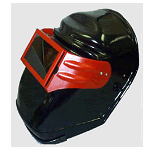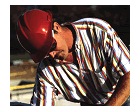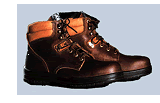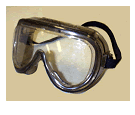
- Home
- Public Employees Occupational Safety and Health
- PEOSH Health Standards
- PEOSH Personal Protective Equipment (PPE) Standard (29 CFR 1910.132 – 138)
PEOSH Personal Protective Equipment (PPE) Standard (29 CFR 1910.132 – 138)
Hazards exist in every workplace in many different forms:
- sharp edges
- falling objects
- flying sparks
- chemicals
- noise;
and a myriad of other potentially dangerous situations.
PEOSH requires the use of personal protective equipment (PPE) to reduce employee exposure to hazards when engineering and administrative controls are not feasible or effective in reducing these exposures to acceptable levels. As of June 2008, the Standard explicitly states that New Jersey public employers are required to pay for the PPE necessary for compliance [pdf 68k].
PPE includes devices for protecting the eyes, face, head and extremities as well as protective clothing, protective shields and barriers.
Where respirators are required to protect worker health, public employers must comply with the PEOSH Respiratory Protection Standard (29 CFR 1910.134).
Requirements for hearing protection are covered in the PEOSH Occupational Noise Standard.
PEOSH originally adopted the federal OSHA Personal Protective Equipment Standard on August 5, 1996. PEOSH adopted OSHA’s revised Standard (incorporating employer payment for PPE) on July 21, 2008. The text of the current PEOSH Personal Protective Equipment Standard resides on the federal OSHA website.
The NJ Department of Labor and Workforce Development (DOLWD) and the New Jersey Department of Health (NJDOH) share jurisdiction for enforcing the PPE Standard.
In establishing criteria for protective clothing, equipment and devices, the PPE Standard references "American National Standards Institute" or "ANSI" guidelines which can be obtained through the ANSI website. Many PPE vendors are familiar with the ANSI criteria for their products.
There are several parts of the PEOSH Personal Protective Equipment Standard:
- General Requirements of the PPE Standard
- Eye and Face Protection Provisions
- Head Protection Provisions
- Foot Protection Provisions
- Electrical Protective Equipment Provisions
- Hand Protection Provisions
General Requirements of the PPE Standard
The general requirements of the PPE Standard requires employers to:
- Assess the workplace to determine if hazards are present which necessitate the use of PPE
- Prepare, sign, and date a "Certification of Hazard Assessment"
- Select and issue the appropriate PPE at no cost to employees
- Train employees about the following items:
- when the PPE is necessary
- what PPE is necessary
- how to properly don, doff, adjust and wear the PPE
- limitations of the PPE
- proper care, maintenance, useful life and disposal of the PPE
Appendix B of the Standard provides a resource for assessing hazards and selecting equipment: "Compliance guidelines for hazard assessment and personal protective equipment selection"
Eye and Face Protection Provisions
 The eye and face protection provisions of the PPE Standard requires employers to ensure that:
The eye and face protection provisions of the PPE Standard requires employers to ensure that:
- Each employee uses appropriate eye or face protection when exposed to eye or face hazards from flying particles, molten metal, liquid chemicals, acids or caustic liquids, chemical gases or vapors, or potentially injurious light radiation.
Eye and face protection must conform to American National Standards Institute (ANSI) criteria referenced in the Standard.
Note: The PEOSH Medical Services and First Aid Standard (29 CFR 1910.151(c) requires that suitable facilities for flushing the eyes and body be available for immediate emergency use where there is a potential for exposure to corrosive materials.
Head Protection Provisions
The head protection provisions of the PPE Standard requires employers to ensure that:
 Each affected employee wear protective helmets when working in areas where there is potential for injury to the head from falling objects.
Each affected employee wear protective helmets when working in areas where there is potential for injury to the head from falling objects.- When employees are working near exposed electricalconductors which could contact the head, the protective helmets worn should be designed to reduce electrical shock hazard.
Protective helmets must conform to American National Standards Institute (ANSI) Criteria referenced in the Standard.
Foot Protection Provisions
The foot protection provisions of the PPE Standard require employers to ensure that:
 Each affected employee wear protective footwear when working in areas where there is a danger of foot injuries due to:
Each affected employee wear protective footwear when working in areas where there is a danger of foot injuries due to:- falling and rolling objects
- objects piercing the sole
- where such employee's feet are exposed to electrical hazards.
Electrical Protective Equipment Provisions
The electrical protective equipment provisions of the PPE Standard requires employers to ensure that:
 When exposed to electrical hazards, employees use electrical protective equipment such as:
When exposed to electrical hazards, employees use electrical protective equipment such as:- insulating blankets
- matting, covers
- line hose
- gloves
- sleeves made of rubber
Hand Protection Provisions
The hand protection provisions of the PPE Standard requires employers to select and require employees to use appropriate hand protection when employees' hands are exposed to hazards such as those from:
- When exposed to electrical hazards, employees use electrical protective equipment such as:
 skin absorption of harmful substances
skin absorption of harmful substances- severe cuts or lacerations
- severe abrasions
- punctures
- chemical burns
- thermal burns
- harmful temperature extremes
- Certification of Hazard Assessment [pdf 8331k]
Template for listing job tasks, hazards and PPE required along with the location, date and signature of person certifying the hazard evaluation as required by the Standard. - Hazard Assessment Worksheets [pdf 41k]
Step-by-step guide for identifying hazards and evaluating control measures and PPE required.
 OSHA PPE Outreach Training for Workers
OSHA PPE Outreach Training for Workers
PowerPoint presentation designed to assist trainers conducting OSHA 10-hour general industry outreach training for workers. Since workers are the target audience, these materials emphasize hazard identification, avoidance, and control - not standards.
- OSHA Personal Protective Equipment Informational Booklet
The information in this guide is general in nature and does not address all workplace hazards or PPE requirements. The information, methods and procedures in this guide are based on the OSHA requirements for PPE as set forth in the Code of Federal Regulations and adopted by PEOSH.
This guide will help both employers and employees do the following:
- understand the types of PPE
- know the basics of conducting a "hazard assessment" of the workplace
- select appropriate PPE for a variety of circumstances
- understand what kind of training is needed in the proper use and care of PPE
- OSHA Non-mandatory Compliance Guidelines for Hazard Assessment and Personal Protective Equipment Selection - 1910 Subpart I App B
Provides compliance assistance for employers and employees in implementing requirements for a hazard assessment and the selection of personal protective equipment. - Canadian Centre for Occupational Safety and Health: Designing an Effective PPE Program
A comprehensive step-by-step guide to developing a PPE Program - Recommended for use as an overall guide, but be aware that the Canadian equipment criteria listed in the document may not be the same as the equipment criteria referenced by OSHA and PEOSH. - CDC National Agricultural Safety Database: Personal Protective Equipment Web Page
PPE resources geared to the agricultural sector but with many applications in New Jersey public sector workplaces. Links to Ohio State University's Agricultural Extension Service. - OSHA Eye and Face Protection Web Page
Provides references to aid in recognizing and evaluating eye and face hazards including possible solutions for these hazards.  OSHA Eye and Face Protection eTool
OSHA Eye and Face Protection eTool
eTools are "stand-alone," interactive, Web-based training tools specializing in occupational safety and health topics. They utilize graphical menus as well as expert system modules. These modules enable the user to answer questions, and receive reliable advice on how OSHA regulations apply to their worksite.- OSHA Technical Manual Section VIII, Chapter I: Chemical Protective Clothing
Describes the various types of clothing that are appropriate for use in chemical operations and provides recommendations in their selection and use. - Personal Protective Equipment for Emergency Responders
Personal protective equipment is very important for any emergency responder. This Web page covers five main types of PPE: respirators and protective clothing (selection, proper use, etc.), skin exposures and eye and hearing protection. - PEOSH Health and Safety Information for Emergency Response Internet LinksLinks to PPE guidance for emergency response situations.

